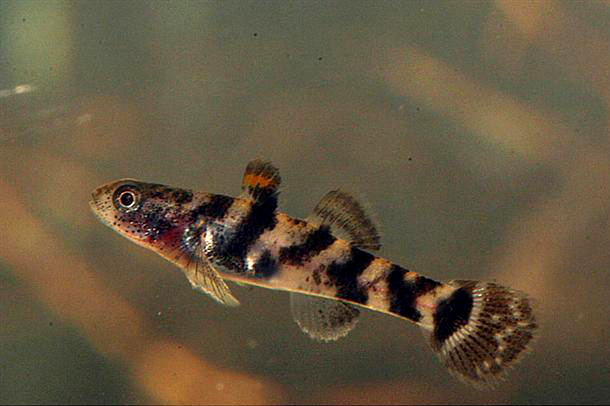Banded Mulletgoby, Hemigobius hoevenii (Bleeker 1851)
Other Names: Banded Mullet Goby

A Banded Mulletgoby, Hemigobius hoevenii, from Leaders Creek, Northern Territory, December 2007. Source: Dave Wilson, Aquagreen / Fishbase. License: CC By Attribution-NonCommercial
Summary:
A greyish to brownish goby with six irregular diagonal blackish bars across the sides, a vertically elongate marbled to ocellated black spot on the caudal-fin base, and a short orange band on the first dorsal fin.
Cite this page as:
Bray, D.J. 2020, Hemigobius hoevenii in Fishes of Australia, accessed 27 Jun 2025, https://fishesofaustralia.net.au/Home/species/3054
Banded Mulletgoby, Hemigobius hoevenii (Bleeker 1851)
More Info
|
Distribution |
Broome, Western Australia, to Townsville, Queensland. Elsewhere the species occurs in the tropical, east-Indo-west Pacific. Inhabits mangrove-lined estuaries and streams, usually concealed beneath leaf litter and detritus. |
|
Features |
Dorsal VI + I,7-8; Anal fin 1,7-9; Longitudinal scales 27-32; Predorsalscales8-10; Vertebrae 26-27. Body robust, compressed; head rounded somewhat depressed; snout rounded, overhanging upper lip; mouth enlarged in males; scales on body ctenoid; predorsal scales extending close up behind eyes, anteriormost scale largest; first dorsal fin low, rounded, with no filamentous spines. |
|
Etymology |
The species is named hoevenii in honour of Pieter Bleeker’s Dutch colleague, zoologist Jan van der Hoeven. |
|
Species Citation |
Gobius hoevenii Bleeker 1851, Natuurkundig Tijdschrift voor Nederlandsch Indië 2: 426. Type locality: Sambes River, Borneo. |
|
Author |
Bray, D.J. 2020 |
|
Resources |
Banded Mulletgoby, Hemigobius hoevenii (Bleeker 1851)
References
Bleeker, P. 1851. Vijfde bijdrage tot de kennis der ichthyologische fauna van Borneo, met beschrijving van eenige nieuwe soorten van zoetwatervisschen. Natuurkundig Tijdschrift voor Nederlandsch Indië 2: 415-442 See ref at BHL
Huang, S.-P., Chen, I.-S. & Shao, K.-T. 2014. The molecular phylogeny of genus Hemigobius (Teleostei: Gobiidae), with the confirmation of validity of Hemigobius crassa (Herre, 1945). Journal of Marine Science and Technology 21(Suppl.): 86-93
Kottelat, M., Whitten, A.J., Kartikasar, S.N. & Wirjoatmodjo, S. 1993. Freshwater fishes of Western Indonesia and Sulawesi. Hong Kong : Periplus Editions 259 pp.
Larson, H.K. 1999. Review of the mangrove goby genus Hemigobius (Gobioidei, Gobiidae, Gobionellinae). The Beagle, Records of the Museums and Art Galleries of the Northern Territory 15: 24-42
Larson, H.K. 2001. A revision of the gobiid fish genus Mugilogobius (Teleostei: Gobioidei), and its systematic placement. Records of the Western Australian Museum Suppl. 62: i-iv + 1-233.
Larson, H.K. & Williams, R.S. 1997. Darwin Harbour fishes: a survey and annotated checklist. pp. 339-380 in Hanley, H.R., Caswell, G., Megirian, D. & Larson, H.K. (eds). The Marine Flora and Fauna of Darwin Harbour, Northern Territory, Australia. Proceedings of the Sixth International Marine Biology Workshop. Darwin : Museum and Art Gallery of the Northern Territory 466 pp.
Larson, H.K., Williams, R.S. & Hammer, M.P. 2013. An annotated checklist of the fishes of the Northern Territory, Australia. Zootaxa 3696(1): 1-293
Larson, H.K. & Lim, K.K.P. 2005. A guide to the gobies of Singapore. Singapore : Singapore Science Centre 164 pp.





